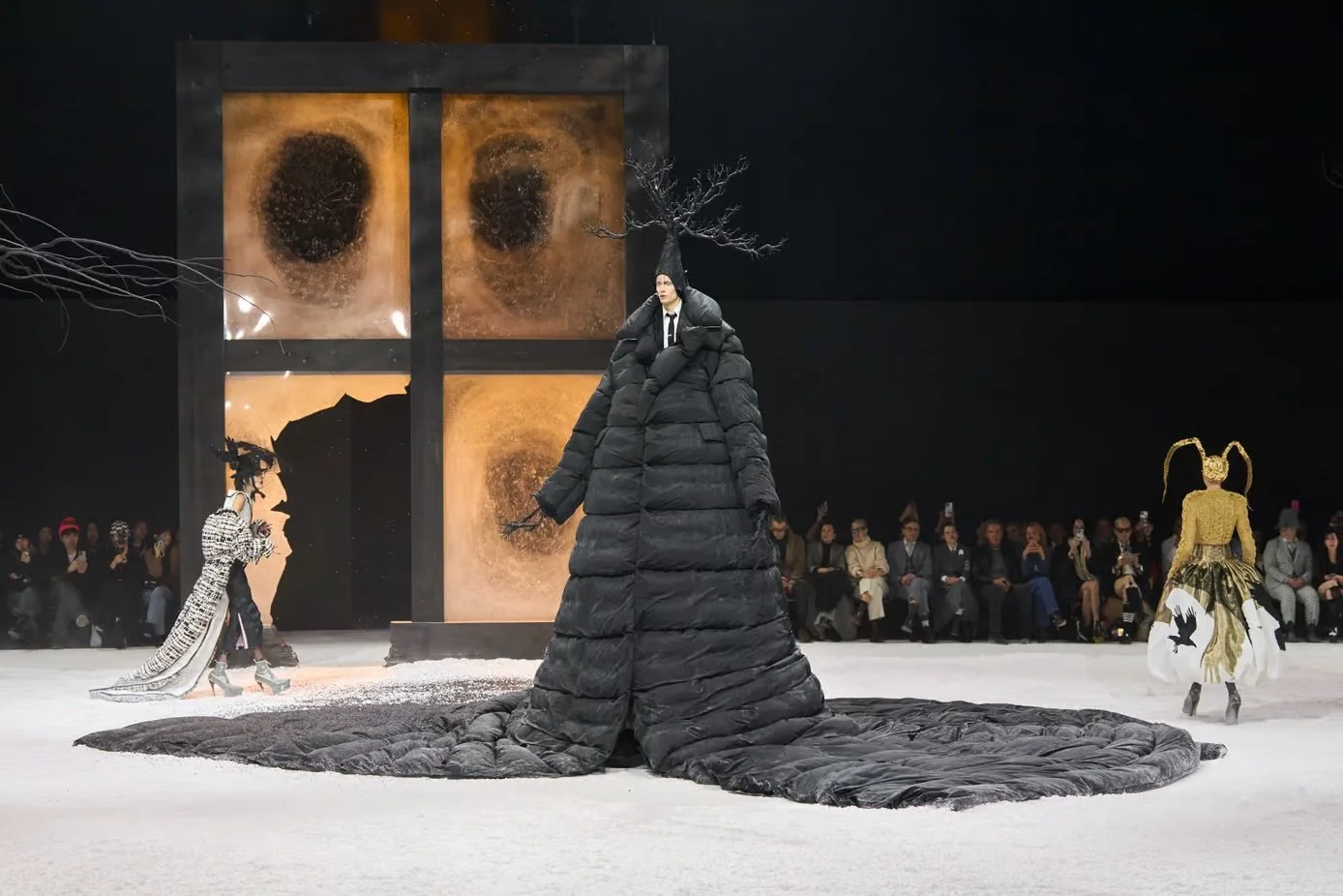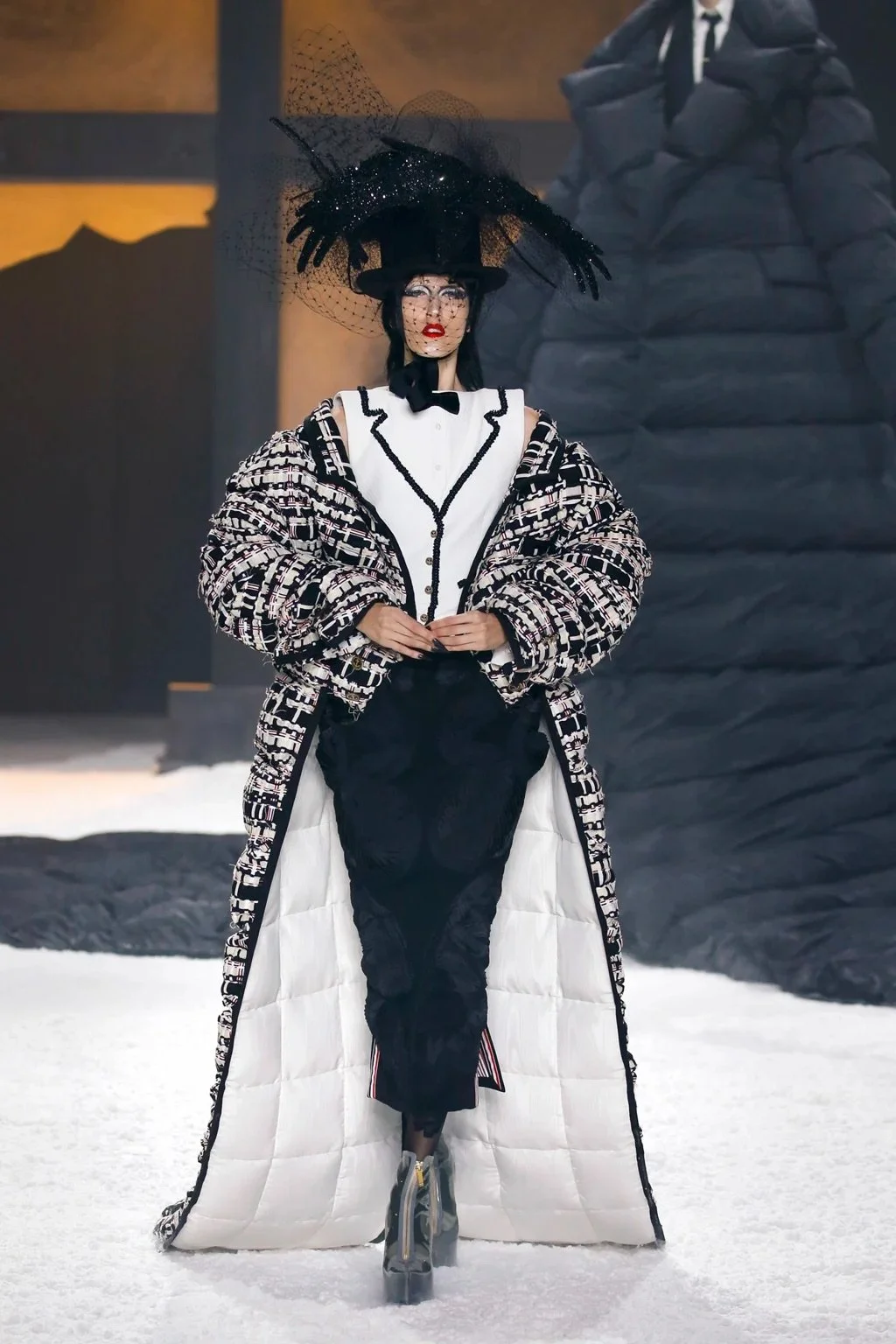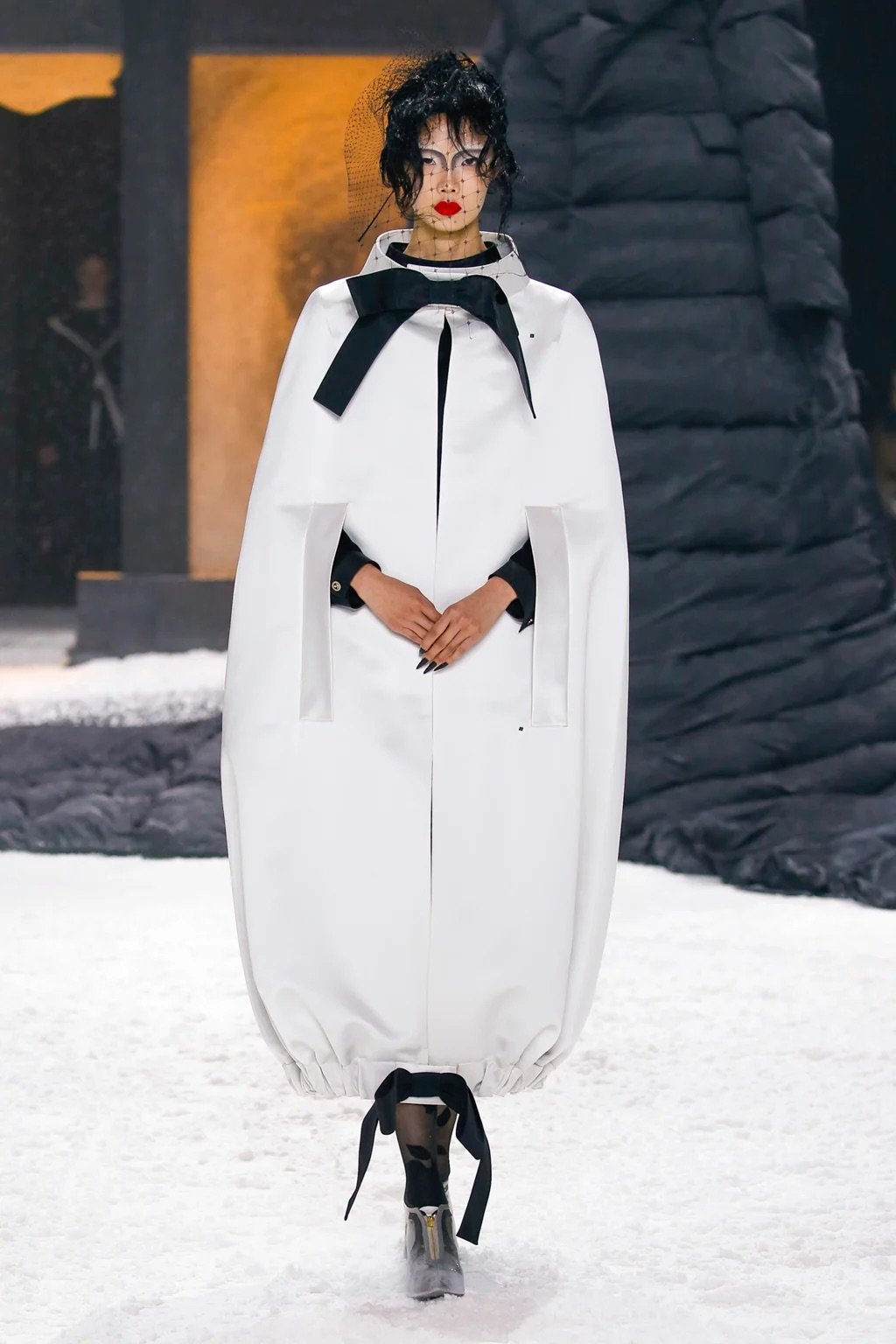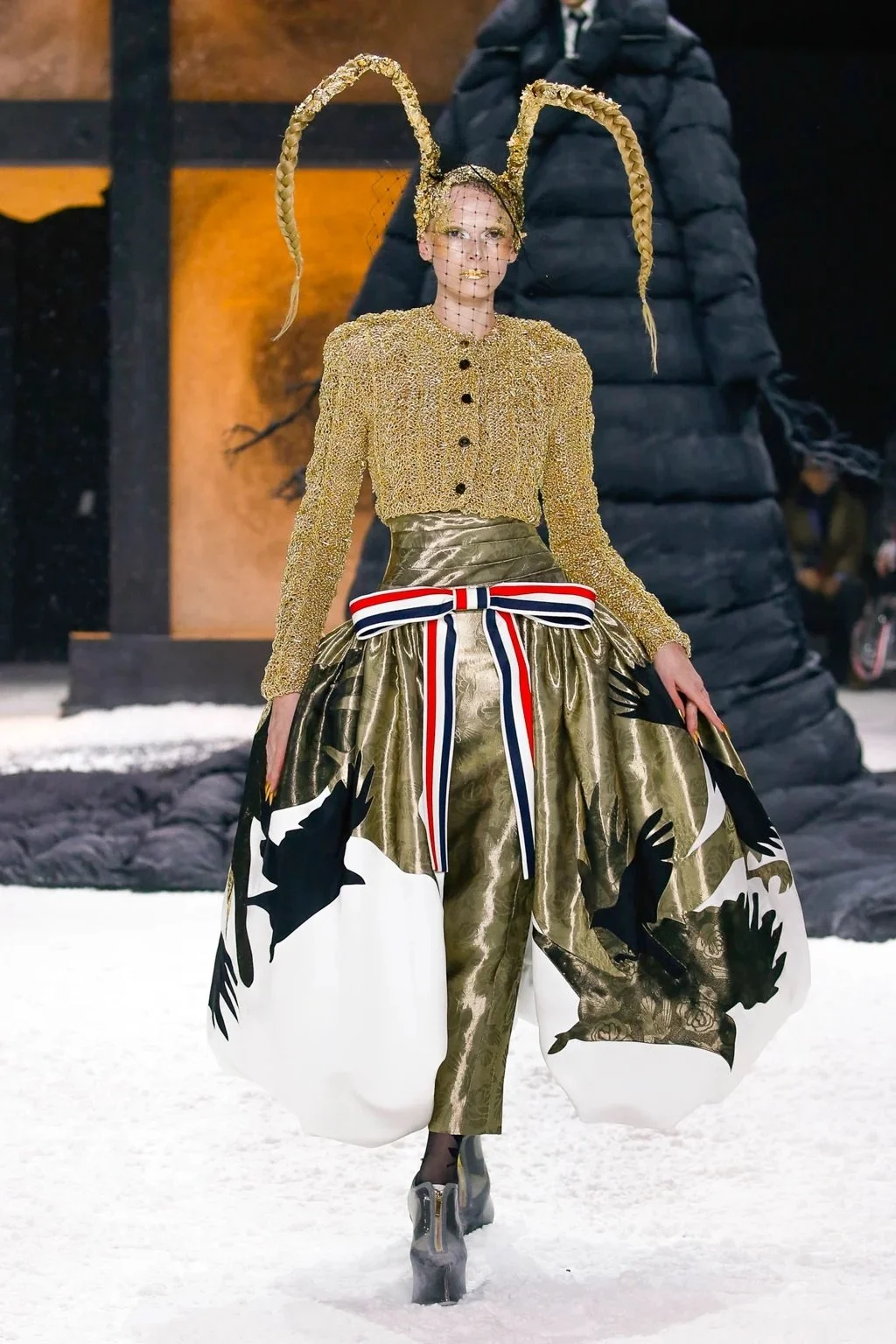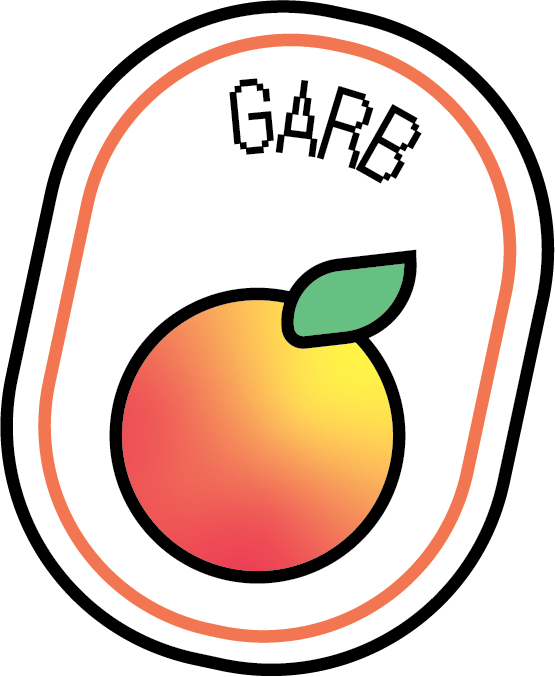Notes on Thom Browne FW24
Thom Browne’s latest collection was hosted again within The Shed in Hudson Yards. This marks a return to the site where Browne’s previous show, inspired by "The Little Prince," enraptured audiences with his usual whimsical charm. This year, Browne once again taps into the literary world to make his first foray into darker themes. Drawing inspiration from the haunting verses of Edgar Allen Poe’s "The Raven," this show is rooted in the macabre beauty of Poe’s world. Browne's prioritization of craftsmanship and unique sartorial expression echo Poe’s era, when high tailoring was revered as the epitome of sophistication. Through a juxtaposition of Victorian elegance and avant-garde flair, Browne pays homage to Poe's tale of loss, mourning, and the ever-present specter of mortality.
The show begins in a barren field. A couple of black fences and dead trees line the stage. Our eyes are immediately diverted to the centerpiece: a model adorned in a 30-foot chesterfield puffer. Branches extend from his arms and head—he’s a tree. A cracked window stands in the background, nearly as tall as the tree. This is the window. It’s a window into the chamber of our main character: the brokenhearted narrator of “The Raven.” Snow covers the entire set. We’re not seeing much of Browne’s signature grey in this collection: color isn’t the focus of this show. From here on out, everything is black and white. Carrie Coon begins narrating Poe’s poem. A woman emerges from the window, wearing a tweed puffer tailcoat that drags on the ground behind her. On feet are stilettos, covered by a layer of waterproof vinyl. Every look in the show includes this waterproof layer, too—the snow is no joke. She’s wearing a massive raven headpiece, wrapped in shredded tuxedos and strips of grosgrain, wool, and canvas. Children emerge from underneath the tree, wearing classic Thom Browne tailoring: they’re in suit shorts and small jackets. They’re all carrying Browne’s famously dog-shaped Hector bags. It’s a styling choice that nods to Browne’s identity as a designer: he never takes himself too seriously, and he doesn’t want his show to be taken too seriously, either. In his own words: “when everything is so serious, it becomes really boring.” The kids gather around the woman, and the story begins. But this story isn’t an exact retelling of “The Raven.” It tells a story of rebirth, too—does the main character continue mourning the loss of his beloved, or will he find a way to break away?
An ensemble of ravens enters through the window. They’re all in black tie looks that have been picked apart and reconstructed. Browne layers coats on top of waistcoats, on top of coats, calling back to the 19th and early 20th century that Poe lived in. The looks are ruffled and disheleved, but still sheen—reminiscent of the feathers of a raven. Browne achieves this effect through his use of modular clothing and disheveled styling, creating a sense of movement and dynamism. Fabrics like mohair, silk, canvas, crepe wool, and cashmere are artfully layered and patched together, contrasting rough and sleek textures. Browne pays homage to their shared New England heritage by incorporating tartan into some jackets, blending denim tweed and velvet intarsia with more traditional New England patterns. Monotone graphics of roses and ravens, alongside explicit references to the raven’s infamous "nevermore," draw direct connections to the romanticism of Poe’s poem. Looks get increasingly darker, shifting away from black and white to full-on black. Funeral veils evoke a sense of mourning and melancholia, mirroring the dark and haunting atmosphere of Poe's work. The incorporation of bows—a trend that’s dominated all of 2024—is present throughout. Their presence adds a hint of playfulness to the otherwise dark ambiance of the collection.
Look 19. So many bows. And waterproof brogues. Distressing on the back of the jacket is really cool if you zoom in. Wish the stripes lined up though.
Bugs make a striking appearance in this show, despite their absence in Poe’s poem. Models' hairdos are meticulously styled to resemble antennae. The show’s final spectacle is heavy with its bug symbolism: Alex Consani is dressed in a massive gold cape with black moiré intarsia ravens and roses. The cape molts away, revealing her in a gold knit cardigan and a silk skirt.
These insect-inspired elements are simultaneously foreboding and hopeful. Bugs are common symbols of decay and despair, but are also used here to suggest a process of shedding the old and emerging anew. We see the emergence of oval-shaped silhouettes that are strikingly reminiscent of cocoons (or are they eggs?). Browne achieves this by widening and lengthening coats and dresses that taper in at the leg. In contrast to the current trend of stiff, structural looks, these fluid shapes create a sense of movement, as they balloon out and sway back and forth. Throughout the show, we’ve heard the narrator pleading with the raven for some sort of divine relief from the death of Lenore, but is always met with “nevermore.” Even in their distressed state, they know that’s the only response they’ll get—their questions are a form of self-harm. Insects exist as a sign that our narrator might find some reprieve from the grief that they’ve been sucked into. The bugs, with their intricate details and delicate forms, also add a sense of fragility and transience to the collection, much like the ephemeral nature of life and the themes of death and loss explored in Poe's writing.
Look 27/Look 49. Both have braids done up to resemble antennae. One look is almost pitch black, and the last is pure gold, with a signature red, white, and blue bow. The first one reminds me a bit of the Mugler ‘97 bug collection
Browne’s design language up to this collection has been a blend of whimsical tailoring and avant-garde flair. With this show, he abandons that whimsicality and embarks on a hauntingly dark journey. Despite his inexperience in this well-explored lane, Browne was able to forge a powerful connection between his designs and the transformative themes at the heart of "The Raven." The result was a captivating and thought-provoking collection that not only paid homage to Poe's literary genius, but also showcased Browne's own remarkable talent for translating complex emotional narratives into sartorial masterpieces. What does this mean for the future of Thom Browne? Was this darker show a one-off occurrence, or will he continue to experiment with his brand identity? The anticipation for what thematic exploration Browne will undertake next is high.

